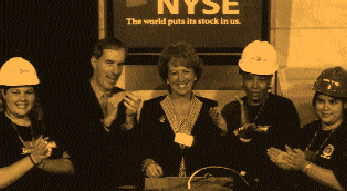Annual Report 2004
Women in the Industry
One of the building community's most important challenges over the coming years will be the recruitment and retention of women in the design and construction workforce. While opportunities for women have increased over the years, the numbers reflect a growth that has been slow and uneven. The situation may be improving, however, thanks to changing dynamics and a commitment among leaders in New York's public and private sectors to ensure that increasing numbers of women are
given opportunities to not just participate but ultimately thrive in historically male-dominated trades and professions.
The following pages examine the history of women in the building industry, the prospects for increased participation over the coming years, and the efforts of many in the industry to make a lasting difference. In addition, this year's Voicing The Challenges 2004 section (pages 5-7) features the observations of women who are already having a notable impact on some of the City's most important projects, policies and capital budgets.
 A Long Road Ahead
A Long Road Ahead
Most of the increasing success of women has come on the professional side, mainly in the architectural and engineering fields. The Bureau of Labor Statistics (BLS) reports that women accounted for 20.4 percent of architects nationally in 2002 - a 30 percent increase from just three years ago.
The best indicator of success in the engineering field comes from the Engineering Workforce Commission, which recently found that the percentage of engineering degrees earned by women has risen from 17.2 percent in 1993 to 23.1 percent in 2002. This trend is reflected in many workplaces, such as the national engineering and design firm The Thornton-Tomasetti Group, where women represent approximately a quarter of the workforce. It is in the construction trades, however, where the statistics indicate that a great deal of work lies ahead. The BLS reports that women make up less than three percent of the construction trades workforce in New York City. And that percentage hasn't changed in two decades. There is one statistic that provides a sense of optimism for the future. According to the Building & Construction Trades Council of Greater New York, five percent of all union trade apprentices in 2002 were women.
The Future is Now
According to industry experts and advocates for women, an exciting window of opportunity has presented itself and will likely grow in the coming years.This is due to two main factors.
- The current construction workforce is aging. "Over the next five to ten years, there will be more turnover (in union trade jobs) than there has been in the past 25 years," notes Building & Construction Trades Council Chief of Staff Paul Fernandes. If the overall volume of work merely remains steady in the coming years, such turnover equates to thousands of job openings.
- All indications are that construction activity will at least remain at current high levels, and probably increase over the next decade. Approximately $12 billion in public and private construction is expected at the World Trade Center site through
the middle of the next decade. New York City is planning to invest up to $5 billion on Manhattan's far West Side, and the Bloomberg administration has unveiled ambitious plans to spur residential housing and school construction. In addition, the Metropolitan Transportation Authority is in the early stages of its most sweeping expansion program since the early 20th century.
The construction industry, as a consequence, could face labor shortages in the near term. The question now is how to ensure that women take advantage of these opportunities.
 Bridging the Gap
Bridging the Gap
"Most of us have just put our heads down and worked all these years," says Patricia J. Lancaster, AIA, Commissioner of the New York City Department of Buildings.”Now, we're talking among ourselves, getting together, and trying to raise the visibility of women and the opportunities for women in our industry.”
Technology may prove an ally for women interested in the construction field. “You don't need brute strength for many of these jobs any more,” says Cauldwell Wingate President Susan L . Hayes, who also heads the Board of Directors for Nontraditional Employment for Women (NEW). “Because of advances in equipment and technology, we don't build like we used to. Construction is now a more appropriate job for a woman. Bringing women into these jobs is not just a moral issue. It’s a practical business decision.”
An immediate focus for construction industry women is to programs and related activities, and to grow female representation through improved retention. NEW, founded in 1978 to prepare New York City women for building trades apprenticeships, is hard at work on both fronts. In May 2003, the group organized a Mother's Day rally in Columbus Circle to honor women working at job sites across the City and to recognize Bovis Lend Lease LMB, Inc. and The Related Companies, for their support of women-owned businesses at their Time Warner/Columbus Centre construction project.
To better understand the barriers to recruitment and retention, NEW commissioned the Center for Women and Work at Cornell University's School of Industrial and Labor Relations to identify commonalities among NEW program graduates who had succeeded in the trades. The success predictors reported in the soon-to-be-published study, “Pioneers, Settlers or Passers-by: Women in the Building Trades,” include a solid employment track.
An immediate focus for construction industry women is to increase awareness of opportunities, through mentoring record in any field, motivation for economic achievement (i.e. heads of household), and familiarity with blue-collar work. Women with exposure to non-traditional employment, such as military service, also do well. As a result, NEW is now focusing its recruitment efforts more closely on women with the identified success characteristics in an effort to increase the number of women who stay on the job. “We have to achieve a critical mass in order for the industry to be more accommodating to women,” explains Francine Moccio, Ph.D., executive director of the Center. “Small numbers don't change the work environment.”

Reaching out to girls and breaking down stereotypes are essential components of long-range success. “It’s such a non-traditional job that it’s an involved process to overcome years of girls not being steered toward this type of work,” says Fernandes.
Aine Brazil, a structural engineer and Managing Principal at Thornton-Tomasetti, echoes this opinion. “Our ability to influence is by going back to children in school and letting them see
role models. But, that's a long-term view.”
On a national level, groups like Women Engineering Programs and Advocates Network (WEPAN) have grades K-12 outreach programs to bring information about engineering careers directly into the classroom.
In New York, the Building Trades Council is seeking ways to partner with NEW to increase participation by female New York City high school students in its Construction Skills 2000 program which accelerates access to union apprenticeships.
Additionally, outreach to high school students is proving effective in supplying new labor. Of the approximately 500 Construction Skills 2000 participants since its inception three years ago, 350 have entered apprenticeships. Ninety continued on to college, and the balance sought other job opportunities. Given the program's successful track record, officials are now looking to see how it might be applied to women.
Women Are The Future
“There is no underestimating the challenge in front of us, but all the elements are in place for a sea change in terms of how this industry views women, and how women view this industry,”
says Marilyn Jordan Taylor, a Partner in the architectural firm Skidmore Owings & Merrill and immediate Past Chairman of the Building Congress. “I have the utmost confidence that, if all segments of the building community work together and with purpose, we will experience dramatic improvement in the coming decade,” Taylor concludes.



